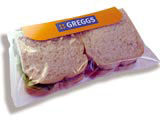Material cause
A throwaway culture means designers have to look at the entire product’s life cycle.

For the majority of people, recycling has become a household chore. Yet, sustainable issues in packaging have an effect that go beyond individual actions and are part of the larger life cycle of things. It is certainly more complex than just recycling.
‘People put too heavy an emphasis on environmental factors,’ says Jane Bickerstaffe, director of Incpen, the Industry Council for Packaging and the Environment – a group of leading packaging producers and retailers. ‘We automatically assume that recycling is better, but it has its own cost burdens.’ While recycling plays a role, Bickerstaffe suggests, its effect on reducing energy and resource use is marginal. If anything, disproportionate interest in recycling diverts attention from more holistic measures.
Sustainability is as much about delivering functionality as it is about saving the environment. Edward Denison and Guang Yu Ren, authors of Packaging Prototypes 3: Thinking Green, which is the latest in RotoVision’s Design Fundamentals series, call for a more systemic, evolutionary approach. Citing Victor Papanek’s 1971 dictum ‘Designers have become a dangerous breed’, they see packaging as a potent symbol of modern materialism’s throwaway culture.
Denison and Ren’s advice is sound. Packaging needs to be a problem-solver, not a problem-creator. Clearly, there have been significant advances in terms of lightweighting, transport and material. Denison and Ren add, ‘The call to simplify the package, concentrate on the product and reduce the space surrounding it, requires a confluence of professional input.’ That means working more closely with technicians and engineers, as well as materials and marketing specialists.
According to John Mays, steel packaging recycling manager at Corus and a member of the Packaging Solutions Advice Group, sustainability has ‘three layers’: process, product and end of life. ‘People often look at packaging in isolation from product,’ says Mays. ‘That’s misleading. We have to look at the total system of the pack and its contents.’
The Body Shop head of design Paul Porral certainly endorses what he calls a ‘total packaging strategy’. ‘Our approach is to minimise packaging waste unless something needs to be protected,’ says Porral. The Body Shop operates a refillable policy and consumers can bring back accessories like brushes and combs, which are recycled to make new products. Sustainability works for The Body Shop because it refocuses the brand on its core values.
At present, consultancies tend to see sustainability as a niche concern. When Lewis Moberly created packaging for Cafédirect, says account director Nicola Cooper, the design had to meet certain ethical and organic requirements. She adds, ‘The total approach was not to over-package or be too complicated.’
Dragon director Dorothy Mackenzie says that sustainability is ‘difficult to implement’ and questions whether it is compatible with volume. ‘Less is best. Achieving simplicity is relatively straightforward. Packaging can be both highly efficient and highly aesthetic,’ she says. Mackenzie cites Duracell’s cardboard-engineered battery packs as an example – as do Denison and Ren. ‘It doesn’t look aggressively environmental. Having no unnecessary layers saves money and is part of a continuous process of looking at packaging costs. You have to justify complex packaging these days,’ says Mackenzie.
In fact, sustainable practices are already present in much of manufacturing – partly because of cost sensitivity, but also because European Union legislation sets targets for controlling packaging waste. ‘Lifecycle analysis’ is established in many companies, although Bickerstaffe says it has become rather ‘academic’.
So might a degree of ‘lifestyle analysis’ show consumers to be more receptive than would otherwise have been thought? The American futurologist Gerald Celente notes a trend towards ‘voluntary simplicity’ – the main question for adherents being ‘how much do I really need?’ – and, closer to home, Kari Butler has researched the issues rising from ‘food on the move’. Butler is programme leader of the packaging degree course at The Surrey Institute of Art & Design. She says, ‘As people increasingly eat at their desks or while they commute, packaging has to be easy to use and collapsible.’
‘Everybody loves to hate packaging’, says Bickerstaffe, and it is over food packaging, both fast and fresh, that emotions run highest. But Bickerstaffe says the industry should be positive about the technological aspects – like modified atmosphere packaging – that consumers take for granted.
Pethick & Money creative director Julian Money relishes the challenge of packaging in this sector. And in 1997, with design partner Katherine Pethick, he set up Rapid Action Packaging. RAP produces Pethick & Money’s flexible food wrap. ‘It’s not a bag and it’s not a box’, says Money. ‘It’s a combination of paper and board that creates a receptacle that’s half the weight and uses half the materials of the standard plastic triangle.’
RAP supplies Pret A Manger’s board wedge sandwich box and has developed packaging for Greggs that is being rolled out nationwide. The paper is coated with a thin layer of polyethylene, but is still classed as mono-material. RAP intends to use a more environmentally friendly alternative for future production.
As Denison and Ren suggest, ‘The flexible food wrap is set to challenge the old generation of packaging as it offers clear advantages to the consumer and the environment.’ Interestingly, Money thinks the board wedge is a return to more traditional methods. And with advertising in recession, clients might look at packaging to convey brand messages.
-
Post a comment



